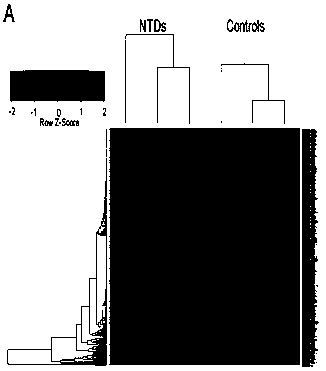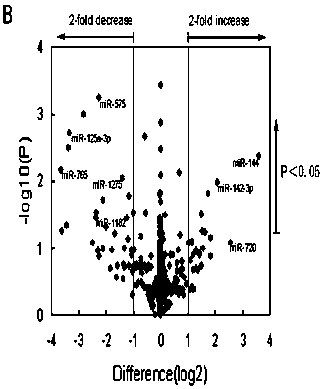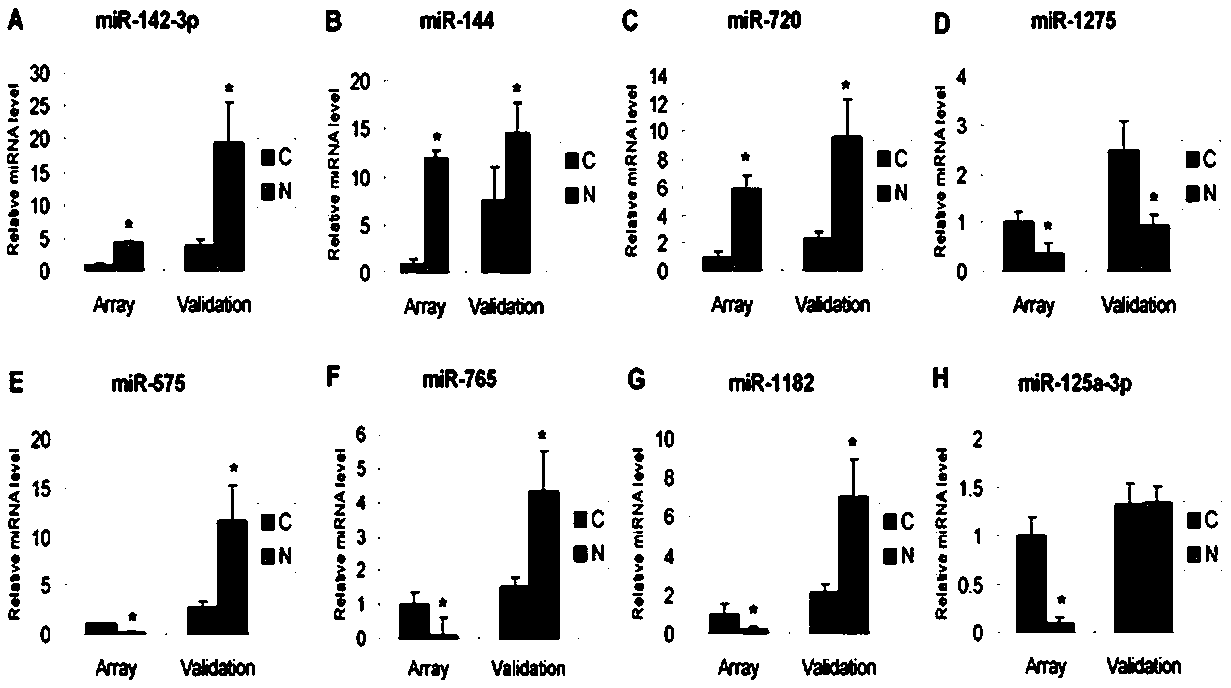A kind of molecular marker and its application for preparing biomarker reagent
A molecular marker and biomarker technology, applied in the fields of biotechnology, laboratory medicine, biochemistry and molecular biology, and clinical medicine, can solve the problems of many influencing factors and complex pathogenesis of neural tube defects, and achieve huge economic and The effect of social benefit
- Summary
- Abstract
- Description
- Claims
- Application Information
AI Technical Summary
Problems solved by technology
Method used
Image
Examples
Embodiment 1
[0041] The application of the miRNA molecular marker of the present invention in the prenatal diagnosis of neural tube defects has achieved very satisfactory results. 33 pregnant women with neural tube defects and 33 normal pregnant women were selected, and the expressions of 6 miRNAs (miR-144, miR-142-3p, miR-720, miR-1275, miR-575 and miR-765) in the serum of these pregnant women were detected The results showed that miR-144, miR-142-3p, miR-720, miR-575 and miR-765 were significantly highly expressed in the serum of pregnant women with neural tube defects, and miR-1275 was significantly low expressed in the serum of pregnant women with neural tube defects. There were significant differences in comparison with the normal group. ROC curve analysis showed that the areas under the ROC curve (AUC) of miR-144, miR-720, miR-142-3p, miR-765, miR-1275 and miR-575 were 0.702, 0.680, 0.676, 0.646, 0.624 and 0.633. The area under the curve of the combined diagnosis of 6 miRNAs was 0.8...
Embodiment 2
[0043] The application of the ceruloplasmin of the present invention in the prenatal diagnosis of neural tube defects has also achieved very satisfactory results. The concentration of ceruloplasmin in the serum of 40 pregnant women with neural tube defects and 40 normal pregnant women was detected by ELISA method, and compared with the alpha-fetoprotein commonly used in clinical screening for neural tube defects. It has good sensitivity and specificity in diagnosis (the area under the ROC curve is 0.979), which is better than that of alpha-fetoprotein currently used clinically (the area under the ROC curve is 0.938) ( Figure 10 , Figure 11 shown).
Embodiment 3
[0045] The application of the proprotein convertase subtilisin 9 (PCSK9) of the present invention in the prenatal diagnosis of neural tube defects has also achieved very satisfactory results. Using ELISA method to detect the concentration of serum PCSK9 in 46 pregnant women with neural tube defects (Table 2) and 46 normal pregnant women, the results showed that the concentration of PCSK9 was higher in the 15-20 weeks of pregnancy, 23-27 weeks of pregnancy and 37-40 weeks of pregnancy. The serum levels of pregnant women were 215.80±88.41 ng / ml, 240.56±56.39 ng / ml, and 322.50±80.39 ng / ml, which were significantly lower than those of normal pregnant women (normal pregnant women at 15-20 weeks, 23-27 weeks and 37- 40 weeks were 297.00±61.51ng / ml, 333.23±66.40 ng / ml and 456.03±58.70 ng / ml) (P Figure 12 shown).
[0046] Table 2 Clinical data of pregnant women with neural tube defects
[0047]
PUM
 Login to View More
Login to View More Abstract
Description
Claims
Application Information
 Login to View More
Login to View More - R&D
- Intellectual Property
- Life Sciences
- Materials
- Tech Scout
- Unparalleled Data Quality
- Higher Quality Content
- 60% Fewer Hallucinations
Browse by: Latest US Patents, China's latest patents, Technical Efficacy Thesaurus, Application Domain, Technology Topic, Popular Technical Reports.
© 2025 PatSnap. All rights reserved.Legal|Privacy policy|Modern Slavery Act Transparency Statement|Sitemap|About US| Contact US: help@patsnap.com



